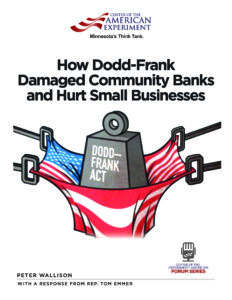Government, Not Wall Street, Caused Financial Crisis
 The Trump administration is right to call the Dodd-Frank legislation passed in the wake of the 2008 financial crisis a “massive government overreach.” As critical repair efforts begin in Washington, it is important to realize that the crisis was not caused by greed, Wall Street risk-taking, and lack of private sector regulation, as is the dominant narrative advanced by the Democrats and the media.
The Trump administration is right to call the Dodd-Frank legislation passed in the wake of the 2008 financial crisis a “massive government overreach.” As critical repair efforts begin in Washington, it is important to realize that the crisis was not caused by greed, Wall Street risk-taking, and lack of private sector regulation, as is the dominant narrative advanced by the Democrats and the media.
Instead, the crisis was set up by well-intentioned but reckless government housing policies going back to the 1990s, and the crash was triggered by blunders of historic proportions by the Treasury Department and the Federal Reserve. The misguided Dodd-Frank legislation that resulted has led to the weakest economic recovery since 1960, a dearth of new community banks forming, and small businesses unable to get credit.
Affordable housing goals turned into mortgage quotas that continued to be raised over time, reaching by 2008 an almost impossible 56% of loans that had to be made to people that were at or below median income. To reach goals underwriting standards had to be reduced. Three percent down payments became zero down payments. People who could afford prime mortgages didn’t want them anymore because putting less down meant they could afford a bigger house. This is how an attempt to help low-income borrowers led to a gigantic housing bubble by 2006.
The bubble began to deflate in 2007 as those overextended could not refinance, and an unprecedented number of mortgages went into default. In March 2008, an investment bank that had heavily invested in the housing market named Bear Stearns was in trouble. The government bailout of Bear Stearns was a big mistake because it sent the message to other firms to just hang on and the government will bail you out. It also convinced bigger firms that raising more equity to improve their financial position was not necessary.
By September 2008 Lehman Brothers, a much larger firm, was in trouble. To everyone’s surprise, in another huge error, the government allowed them to fail. As Dodd-Frank expert Peter Wallison told an American Experiment audience last year: “It reversed the policy that had caused everyone to believe that things were going to be stabilized by government action. The shock of the government’s illogical and unexpected failure to act was what caused the financial crisis. Investors, already concerned about the health of these larger firms now wanted cash. Liquidity dried up.”
Mistakenly blaming Wall Street Greed for the crisis resulted in the avalanche of regulation known as the Dodd-Frank Act, which, according to Wallison, “has put the federal government in substantial control of most of our financial system.” Now instead of 100 new community banks a year we get three, and sometimes one. Small business, the prime driver of new jobs (about 20 percent each year) doesn’t receive the credit it needs to form or grow. Overall, we are now plagued by a feeble, historically low, rate of economic growth.
One of the most important things that President Trump and the Republican Congress can do to unleash growth and broad prosperity is to remove the unnecessary regulations contained in Dodd-Frank.
Peter Zeller is Director of Operations at Center of the American Experiment.